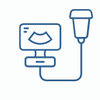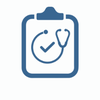Department Overview
We provide a digital diagnostic imaging service to our patients and healthcare professionals. Services are also provided to GP's and other external referrers.
Our department uses the latest and most advanced medical devices and equipment. With this we perform a wide range of medical tests and diagnostic imaging.
The Radiology Team
There are a range of different staff working in Radiology. This ensures we can provide the best service possible to the patients using our service and those who refer into our service. The Radiology team consists of:
- attendant/ assistant staff
- clerical staff
- nursing staff
- radiographers
- radiologists
Radiographers are trained professionals who operate various imaging equipment e.g. X-ray machines, CT and MRI scanners. They create images of the body for diagnostic purposes and are expert in the safe use of the different technologies involved. Radiologists are doctors who look at medical images, like X-rays or scans, to find signs of illness and help plan the best treatment.
We are here to help so please ask any staff member should you require any assistance or further information during your visit to Radiology.
Services and Types of Analysis/Imaging Provided by the Department
Radiation Safety
Examination Information
|
X-ray Examination |
Equivalent Period of Background Radiation |
|---|---|
|
Chest, dental, arms and legs, hands and feet |
A few days |
|
Skull, head, neck |
A few weeks |
|
Breast, hip, spine, abdomen, pelvis, CT of head |
A few months to a year |
|
Kidneys and bladder (IVP), stomach (barium meal), colon (barium enema), CT chest, CT abdomen |
A few years |
Important points to remember
- We make every effort to keep the radiation dose to patients as low as possible.
- Radiation from X-rays is usually small. It is less than what we get from natural background radiation. It can be equal to a few days or a few years of natural radiation.
- The health risks from X-ray exams are very small compared to the natural risk of cancer. Yet, they are not completely zero.
- You should make your doctor aware of any other recent X-rays exams you may have had. This may impact their decision to request further examinations.
- The risks are much lower for older people and a little higher for children and unborn babies. Extra care is taken with young or pregnant patients. If you are concerned about the possible risks, speak with your doctor. Find out if the examination is necessary. If so, the risk to your health may be higher from not having the examination.
To understand radiation exposure levels, here is a table. It shows common X-ray exams and the equal period of natural background radiation that gives the same dose.
Frequently Asked Questions
|
Frequently Asked Questions |
|
|---|---|
|
What are the different types of x ray? |
Radiography This is the familiar X-ray which most of us will have at some time during our lives. It is usually for looking at broken bones, the chest or teeth. A machine directs a beam of X-rays through the part of your body that is being examined and on to a detector. An image is produced of the structures the X-rays have passed through in your body. X-rays such as these involve relatively low amounts of radiation. Fluoroscopy This is sometimes called ‘screening’. An X-ray beam passes through your body and is viewed by a detector, which produces a moving picture on a screen. The Radiologist or Radiographer performing the examination records any important findings. These are sent back to your doctor. Fluoroscopy is often used to look at the digestive track. For example, in a ‘barium swallow’ you will be asked to swallow a barium based liquid. This allows the Radiologist to see the size and shape of your upper gastro-intestinal tract. Fluoroscopic examinations usually involve higher radiation doses than simple radiography. CT CT, or Computed Tomography, exams combine a series of X-ray images taken from different angles. This creates a more detailed view. For certain CT exams, you may need to swallow a barium based liquid. This helps the Radiologists better visualise various structures in the body. The radiation dose from a CT exam depends on the part of the body that is being imaged. It is typically higher than simple radiography. DXA A Bone Densitometry or DXA (‘Dexa’) scan is a very low radiation dose X-ray of the lower spine and hip, and sometimes the forearm. Low dose X-rays pass through the bones and tissues in these regions. A special software is used to analyse the images and display the bone density. DXA scans can be used to screen for osteoporosis, osteopenia as well as check for bone fracture risk. They are quick and painless. They are the lowest radiation doses of the examinations we perform the department. |
|
Are X-rays safe? |
Patients are sometimes concerned about the possible harmful effects of X-rays, so this page will explain the risks and put them into perspective. X-rays are only used if the benefit to the patient outweighs the small risk involved. |
|
What are the benefits of having an X-ray? |
Using X-rays for diagnosis can bring very real benefits to patients. Our aim is to make sure the benefits of the right diagnosis and treatment outweigh the minimal risks associated with X-ray radiation. |
|
Is it possible to avoid radiation completely? |
We are all exposed to natural background radiation every day of our lives. This comes from the ground and building materials around us, the air we breathe, the food we eat and even from outer space (cosmic rays). In most of Ireland the largest contribution is from radon gas which seeps out of the ground and accumulates in our houses. Each medical X-ray gives us a small dose on top of this natural background radiation. The level of dose varies with the type of examination. This ranges from the equivalent of a few days of natural background radiation to a few years. |
|
Is there some other way to make the diagnosis? |
Before sending you for an X-ray, your doctor will have considered the other types of tests. X-rays are used when they are judged to be the most suitable method of assisting diagnosis. |
|
Are X-rays dangerous? |
The radiation doses used for X-ray examinations are too low to produce immediate harmful effects. The only known effect on patients from these low doses is a very small increase in the chance of getting cancer many years or even decades later. |
|
Why should I accept any risk? |
All activities carry some level of risk. We regard activities as “safe” when the risk of something unpleasant happening falls below a certain level. The benefits from any X-ray examination usually outweighs the small radiation risk. Higher dose examinations are normally used to diagnose more serious conditions. In these cases the benefit far outweighs the risk. It is important that you make your doctor aware of other X-rays or scans you have had. It may make additional examinations unnecessary. |
|
Are the risks the same for everyone? |
As you get older, you are more likely to need an X-ray examination. Radiation risks for older people tend to be lower than for others. This is because there is less time for a radiation-induced cancer to develop. Children, are at a higher risk than middle-aged people from the same X-ray examination. This is why there must be a clear medical benefit for every child who is referred for an examination that uses X-ray radiation. The radiation dose is kept as low as possible without detracting from the information the examination can provide. A fetus may also be more sensitive to radiation than an adult, so we are particularly careful about X-rays during pregnancy. There is very little risk with exams like an X-ray of the hand or the chest because the radiation is not near the fetus. However, special precautions are required for examinations where the fetus is in, or near, the beam of radiation If you are a woman of childbearing age, the radiographer or radiologist will ask you if there is any chance you could be pregnant. If you could be pregnant your doctor will decide whether or not to recommend postponing the exam. There will be occasions when diagnosing and treating your illness is essential for your health and your unborn child. When the benefit far outweighs the small radiation risks, the X-ray exam may go ahead after discussing all the options with you. |
CT / CAT - Patient Information
Your doctor has requested that you have a CT (or’CAT’) Scan. This is a special type of X-ray examination, which takes detailed images inside the body. This includes the brain, lungs, other internal organs, bones, soft tissues and blood vessels.
What happens on the day of examination?
Enter the hospital via the main entrance on Craddockstown Road. The Radiology Department is signposted from there and is a short distance away. On checking in at radiology reception you will be registered for your scan and directed to the CT waiting area. The radiographer will attend to you there and provide further instructions relevant to the type of CT scan you are having e.g. you may need to drink a special liquid (‘oral contrast’) prior to your scan to demonstrate certain body parts more clearly on the scan. Sometimes we need to use intravenous (IV) contrast agent to help highlight other areas of the body for the scan. In this case, a small cannula will be inserted into a vein in your arm. You may be requested to change into a hospital gown prior to your scan.
What does the procedure involve?
During the scan, you will usually lie on your back on a movable narrow bed that passes into the CT scanner. The scanner consists of a doughnut-shaped ring a part of which rotates around a small section of your body as you pass through it. The radiographer will operate the scanner from the next room. While the scan is taking place, you will be able to hear and speak to them through an intercom and they can see you at all times. While each scan is taken, you will need to lie very still and you may be asked to hold your breath- this ensures that the scan images are not blurred. If you need the IV contrast it will be passed into the cannula in your arm during the scan. The radiographer will explain the injection process and mild effects of the contrast injection (slight heat, metallic taste etc) to you. CT scans take from 5-10 minutes to complete.
Is there any preparation?
Your appointment letter will mention anything you need to do to prepare for your scan e.g. you may have to fast for a number of hours prior to the scan.
If your scan will involve the use of the IV contrast you may need a blood test in advance of the scan. It is important you inform us in advance if you have ever had an allergic reaction to contrast in the past.
Certain CT scans in females of child-bearing age (12-55 years) need to be carefully scheduled to ensure the patient is not pregnant at the time of scanning - this will be organised with the person making your appointment.
After the scan
Once all your images are acquired and checked you are free to leave the department. The Radiographer will advise you regarding getting your results.
You must always ensure you receive the results of the scan from the doctor that referred you.
*By undergoing a CT scan, you are consenting to being exposed to ionising radiation to help diagnose your condition. You can decide at any stage not to proceed with the examination. In this case please inform the Radiographer looking after you. Information on the benefits and risks of radiation is available in the Radiology Department.
DXA - Patient Information
Your doctor has requested that you have a DXA (or Dexa) Scan. This is an X-ray examination, which provides information about the Bone Mineral Density (strength) of your bones and assesses your risk of breaking a bone.
What happens on the day of examination?
Enter the hospital via the main entrance on Craddockstown Road. The Radiology Department is signposted from there and is a short distance away. On checking in at radiology reception you will be registered for your scan. You will be brought to the DEXA room and you will change into a hospital gown if necessary. You will be weighed and your height measured prior to the scan and the Radiographer will ask you a series of questions relevant to bone health.
What does the procedure involve?
You will lie on your back on the DEXA scanner table and will be moved into the scanning position. The Radiographer will position you accurately for the different images required. Part of the scanner will move over the body as the images are taken. It will not make contact with you and the whole examination is entirely painless. It is important that you remain still during the examination. A total of three images are usually taken – lower back (front and side) and left hip. The entire examination takes approximately 20 minutes to complete.
Is there any preparation?
No – you may eat and drink normally prior to the scan.
If possible please wear loose clothing e.g. tracksuit, elasticated skirt/trousers – no roll-on, corset, underwired bra.
Please ensure that if you are taking calcium supplements that you do not take them on the day of your DXA scan.
A DXA scan cannot be performed until 1 month after a barium study or a CT scan with oral contrast – please let us know if you need to change your appointment for this reason.
After the scan
Once all your images are acquired and checked you are free to leave the department. The Radiographer will advise you regarding getting your results.
You must always ensure you receive the results of the scan from the doctor that referred you.
*By undergoing a DXA scan, you are consenting to being exposed to ionising radiation to help diagnose your condition. You can decide at any stage not to proceed with the examination. In this case please inform the Radiographer looking after you. Information on the benefits and risks of radiation is available in the Radiology Department.
MRI - Patient Information
Your doctor has requested that you have an MRI scan. This study produces very detailed images of the body part being examined and is used to image the brain, spine, internal organs, muscles and joints. MRI does not use X-rays, rather it combines the use of a very large magnet and radio-waves to create the images.
Before the Scan
The MRI scanner consists of a large, very powerful magnet. Because of this,
there are some precautions we have to take at the time of making your scan appointment. You will be asked the following questions:
- Do you have a cardiac pacemaker?
- Do you have any aneurysm clips in your head?
- Do you have any kind of implanted devices in your body?
- Have you ever worked with metal or got metal fragments in your eyes
or anywhere else in your body?
If you answer YES question 1 you may NOT have an MRI scan at NGH
If you answer YES to questions 2 - 4 we will evaluate the situation before making your appointment.
Is there any special preparation?
There is NO preparation for the vast majority of MRI examinations. Continue to eat and drink as normal and take your medication as prescribed. If we do require you to fast or prepare in any other way for your examination you will be given clear instructions when your appointment is being made.
What happens on the day of examination?
Enter the hospital via the main entrance on Craddockstown Road. The Radiology Department is signposted from there and is a short distance away. On arrival at radiology reception you will be registered for the examination. You will be asked to complete and sign a detailed ‘safety questionnaire’ form if you have not done so already.
You will then be brought to the MRI unit where you will be asked to change into a hospital gown. All metallic items e.g. watches, coins, keys, hair clips, lighters, jewellery and items such as credit/ ATM cards must be removed before you enter the scan room.
What does the procedure involve?
The MRI scanner consists of the large tubular magnet and the scanning table. The MRI Radiographer (operator of the scanner) will position you on the table (head-first or feet-first depending on the scan you are having) and move you into the machine. This remains open at both ends all the time and is illuminated. The Radiographer operates the scanner from an adjacent room but can see you and communicate with you at all times during your scan. You can also call/ communicate with the Radiographer at any-time.
Noise – during your scan you will hear a series of loud tapping and knocking sounds. This can last from a few seconds to several minutes at a time. You will be given ear-plugs or headphones playing music/ radio to wear to help block out this noise.
Duration of Scan – The average length of time for a scan is about 20-30 minutes. Some studies may be shorter and other more complex procedures may be considerably longer. It is very important that you remain very still during the examination. If you move while the images are being acquired they will not be useful and will have to be repeated which increases the scan time.
Does it Hurt? – No - MRI is a painless examination. You will not feel any pain or abnormal sensations during the scan. Some examinations require the injection of a contrast medium. This is a substance which improves the visualisation of certain structures within the body. The injection is given through small needle inserted in a vein (usually) in your arm. There are no side effects from this injection.
After the scan
Once all your images are acquired and checked you are free to leave the department. The Radiographer will advise you regarding getting your results.
You must always ensure you receive the results of the scan from the doctor that referred you.
FLUROSCOPY - Patient Information
Your doctor has requested that you have a Barium/ Fluoroscopy Examination . Fluoroscopy is a form of medical imaging that displays a continuous X-ray image on a monitor, resembling a moving X-ray picture.
Fluoroscopy uses X-rays and a contrast agent or ‘dye’ to examine a specific part of your body. The contrast dye shows up white on your X.-ray and helps to show any abnormalities.
The most common fluoroscopy studies @ NGH are:
- Barium Swallows and Barium Meals, which examine the oesophagus, stomach, and small intestine
- Small Bowel Series, which examines the small intestine
- VideoFluoroscopy Studies – performed with Speech and Language Therapists to assess the swallowing function
What happens on the day of examination?
Enter the hospital via the main entrance on Craddockstown Road. The Radiology Department is signposted from there and is a short distance away. On arrival at radiology reception you will be registered for the examination.
You will then be brought to the Fluoroscopy area where you will be asked to change into a hospital gown. You may need to remove jewelry or other items which might obscure the image.
What does the procedure involve?
Barium Studies:
A radiologist, a nurse and a radiographer will be present in the X-ray room. You will be given a small cup of granules and a small fizzy liquid to swallow. These together will expand your stomach so that the stomach can be clearly visualised. Then you will be asked to stand at the x-ray machine and be given a white liquid (Barium) to drink. This will outline the oesophagus, stomach and small intestine. The radiologist will be taking x-rays and viewing these on a screen within the room. The radiologist will lay the table flat and you may be requested to lie on either side so that the stomach can be outlined sufficiently. The examination is entirely painless.
Videofluoroscopy:
The speech and language therapists and a radiographer will be present in the X-ray room. You will sit on a special chair in front of the X-ray machine. The radiographer will take X-rays as you drink and eat different liquids and foods which have a contrast agent or ‘dye’ added. The speech and language therapists will view your images as the examination proceeds. This allows them to assess if the materials are being swallowed correctly or no. They will make recommendations after the study should any modifications to your diet be required.
After the Scan
Once all your images are acquired and checked you are free to leave the department. You can then eat and drink normally and you are advised to drink plenty of water and eat fruit/ vegetables in the following days to eliminate the Barium from your digestive system. The Radiographer will advise you regarding getting your results.
You must always ensure you receive the results of the scan from the doctor that referred you
*By undergoing an X-ray procedure, you are consenting to being exposed to ionising radiation to help diagnose your condition. You can decide at any stage not to proceed with the examination. In this case please inform the Radiographer looking after you. Information on the benefits and risks of radiation is available in the Radiology Department.
ULTRASOUND - Patient Information
Your doctor has requested that you have an Ultrasound Scan. This type of scan uses sound waves rather than X-rays to visualise many body organs (e.g. liver, kidneys, thyroid, ovaries, vascular system etc). Ultrasounds can show the structure and movement of your organs, as well as how blood flows through your vessels.
What happens on the day of examination?
Enter the hospital via the main entrance on Craddockstown Road. The Radiology Department is signposted from there and is a short distance away. On checking in at radiology reception you will be registered for your scan and directed to the Ultrasound waiting area. You may be required to change into a hospital gown for your examination.
What does the procedure involve?
During your ultrasound, a sonographer will apply gel to the area being looked at. This helps the sound waves travel through the skin. Your sonographer will then move a handheld transducer or ‘probe’ over the surface of your skin. You may feel some pressure as the transducer is pressed against the area being examined.
If you are having a pelvic scan, an internal ultrasound scan may be required to visualise the pelvic organs properly. This enables close-up, high-quality images from inside your body. We will always ask you for your consent before proceeding with this. Ultrasound scans take from 15-30 minutes to complete.
Is there any preparation?
Your appointment letter will mention anything you need to do to prepare for your scan. For example: you may have to fast for a number of hours prior to your scan or you may have to drink water to ensure your bladder is full.
After the scan
Once all your images are acquired and checked you are free to leave the department. The Radiographer will advise you regarding getting your results.
You must always ensure you receive the results of the scan from the doctor that referred you.
X-RAY - Patient Information
Your doctor has requested that you have an X-ray. Plain radiography, or X-ray, is the original and most commonly used form of diagnostic imaging. It uses small amounts of radiation that are passed through a selected part of the body to produce an image. Plain radiography is commonly used in the evaluation of the chest and musculoskeletal system.
What happens on the day of the examination?
Enter the hospital via the main entrance on Craddockstown Road. The Radiology Department is signposted from there and is a short distance away. On arrival at radiology reception you will be registered for the examination.
You will then be brought to the X-ray area where you may be asked to change into a hospital gown depending on the body part being X-rayed. You may need to remove jewelry or other items which might obscure the image.
What does the procedure involve?
The radiographer will take you into a room where you will sit, lie, or stand for your X-ray. The radiographer will guide you into different positions depending on the examination you are undergoing. During the X-ray you will need to keep as still as possible. The radiographer will take the images and review them at the end to ensure they are of good quality.
Length of X-ray appointment: around 5-15 minutes.
After the x-ray
Once all your images are acquired and checked you are free to leave the department. The Radiographer will advise you regarding getting your results.
You must always ensure you receive the results of the scan from the doctor that referred you.
*By undergoing an X-ray procedure, you are consenting to being exposed to ionising radiation to help diagnose your condition. You can decide at any stage not to proceed with the examination. In this case please inform the Radiographer looking after you. Information on the benefits and risks of radiation is available in the Radiology Department
Results
X-ray/scan results are generally available within 1 week although it may take your doctor up-to 2 weeks to process.
The results of your X-ray or scan will always be returned to the doctor or healthcare professional who requested the X-ray or scan. If it was a referrer in the hospital the results go back to that referrer, if it was your GP the results go back to your GP. Do not assume if you have not received the results that it means there were no findings. You should always be informed whether the results were normal or otherwise.
GP Information
GP results are available on electronic reporting via HealthLink.
We request that all GPs ensure that they are registered with this service before sending in referrals.


-
Mon-Fri9 a.m. – 5 p.m.








